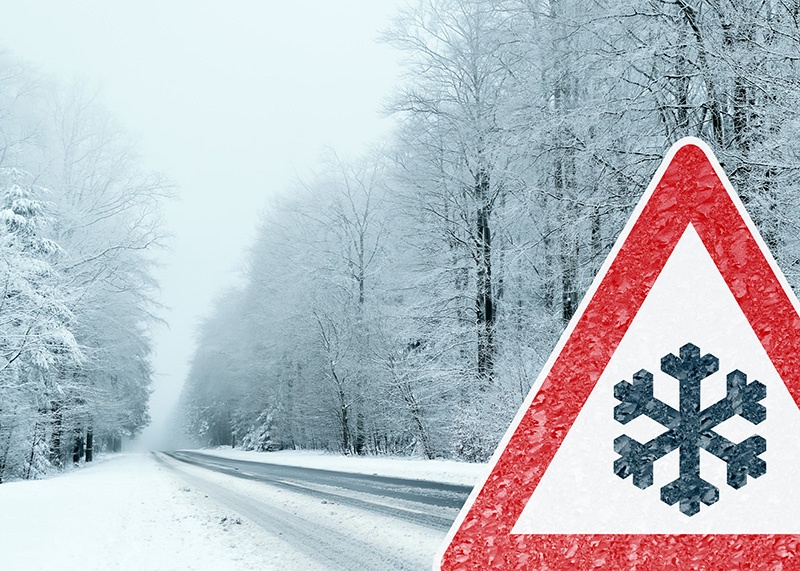How Winter Weather Affects Fuel Economy

If your fleet seems to require refueling more frequently in winter, it’s not your imagination. Cold weather and winter driving conditions can reduce fuel economy significantly because cold, dry winter air is denser than summer air. It impacts vehicles by increasing idle time, lowering tire pressure, and amplifying heavier rolling resistance.
But fear not. Winter doesn’t have to get the best of you and your fleet operations. Gaining the upper hand on winter weather can be as simple as knowing the challenges to expect and the steps needed to reduce their impact.
Let’s look at the challenges.
Cold, Dry Air Is a Gas Guzzler
Cold, dry air is the biggest reason for lower gas mileage in winter. Depending on a vehicle’s make and model, mileage could drop by as much as 20-28% in winter compared to summer.
For conventional gasoline vehicles, the ideal outside temperature for the best mile per gallon (MPG) is 75°F-85°F. MPG decreases rapidly when the temperature drops below 68°F, with the biggest impacts occurring under 45°F.
For hybrids, the effect of winter air is typically greater, with fuel economy dropping 30-34%.
Winter Weather Is a Drag on Vehicles
The aerodynamic drag of a vehicle is proportional to air density. As the temperature drops, the air becomes denser. Aerodynamic drag increases by 2% for every 10° F drop in temperature. And every 2% increase in aerodynamic drag decreases fuel economy by approximately 1%.
Wind speed in winter is higher. Headwinds and crosswinds are common, and can significantly increase aerodynamic drag, resulting in lower fuel efficiency. For every 10 mph of a headwind or crosswind, fuel efficiency is reduced by up to 13%.
Difficult Weather and Road Conditions
According to the U.S. Environmental Protection Agency (EPA), poor road conditions can increase fuel consumption by 7-35%, depending on driving and climate conditions, terrain, vehicle type, and driving habits.
With more asphalt deterioration and snow, ice, slush, water, and sand, roads are rougher in the winter. Offsetting the increased rolling resistance means that engines must work harder, which burns more fuel. Additionally, snow and ice on roads increase wheel slippage — another fuel burner.
Lower Engine Temperature
Engines take longer to reach the most fuel-efficient temperature in cold weather. This affects fuel economy on shorter routes the most since the vehicle spends more time on the route operating at less-than-optimal temperatures.
Higher Loads on the Electrical System
Colder temperatures mean higher electrical loads due to greater demand from electrical components like:
- Defroster
- Heater
- Headlights
- Interior lights
- Heated seats
- Heated mirrors
- Windshield washer pump
The more these electrical components are used, the harder the engine works — resulting in fuel burning faster.
Lower Tire Pressure
In colder temperatures, the air inside a tire contracts, leading to a decrease in tire pressure and an increase in rolling resistance. For every 10°F drop in air temperature, tire pressure decreases an average of one to two pounds per square inch (PSI) — with one PSI drop reducing fuel economy by 0.2-0.4%.
6 Steps to Mitigate Cold Weather Impact on Fuel Economy
Now that you know what winter challenges to expect, let’s look at the proactive steps you can take to mitigate their impact on your operations and fuel economy.
1. Optimize Tire Performance
Regularly check and maintain proper tire pressure to reduce rolling resistance. Consider investing in high-quality, low-rolling resistance tires or winter tires for better fuel economy.2. Reduce Idling
Limit warm-up times by using block heaters to pre-warm engines before starting, especially for diesel vehicles. Set idling policies and goals for drivers. For example, limit idling to no more than five minutes per stop. Finally, train and educate drivers on best practices and techniques to reduce idling.3. Maintain Vehicles
Use the correct engine oil viscosity for winter conditions to reduce friction. Ensure batteries are in good condition to prevent excessive alternator use. Inspect the cooling system to ensure it’s ready for the challenges associated with winter temperatures. And stay on top of regular maintenance intervals.You’ll also want to remove accessories that increase wind resistance and are unnecessary for the job. Additionally, keep vehicles in a garage or covered space to increase the initial temperature of the engine and cabin.
4. Monitor Fuel
Implement telematics systems to track and monitor fuel usage in real time and identify inefficiencies. Set benchmarks and reward drivers for fuel-efficient driving.5. Optimize Routes
Leverage GPS and route optimization software to plan the most efficient routes, avoiding traffic, hazardous conditions, and closed roads. When evaluating options, consider not only “must-have” features but additional features that can lower costs and improve overall efficiency.6. Driver Training
Educate and train drivers on winter-specific fuel-efficient driving techniques and practices, such as gradual acceleration, maintaining steady speeds, minimizing braking, and reducing idling.Winter weather is inevitable, but its impact on fleet fuel economy and operations doesn’t have to be. For more tips on keeping your fleet winter ready, check out our library of related content:
- Best Practices for Keeping Your Drivers Safe and Productive In the Winter
- Tips to Prep Commercial Tires for Winter
- Tips for Winterizing Your Bulk Fuel Tanks
- Choosing the Right Biodiesel Blend for Winter
- Preparing Your Fleet Vehicles for Winter
- 5 Tips to Help Utility Fleets Proactively Prep for Winter